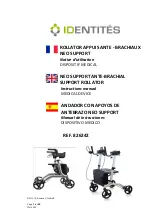
10.
Take special care to lock the casters securely when transferring patient to or from
the chair.
11.
Do not allow the patient to sit on the chair when it is in the prone position. Never
sit or lean on the headrest or the legrest when the chair is in the prone position.
Caution:
Failure to observe these safety precautions may result in personal injury or mechanical
failure. Read all instructions carefully before using the chair.
.
Weight Limit:
Never exceed the weight limit of the chair (combined weight of user and
items on chair). Exceeding weight limit may cause the chair to fail. The weight capacity
of each chair is shown on the back rest and on the serial number label.
.
Power Requirements:
Electrical hazard may occur if the chair is plugged into an
inadequate power supply. A power source of 120 VAC, 50 to 60Hz, with a capacity of at
least 15 amps must be available to operate the chair. A three-wire grounded receptacle
must be supplied. A (ground fault circuit interrupter)
GFCI
is recommended. (maximum
current drawn by the chair is 9 amps)
.
Battery Back-up:
The system’s battery automatically charges when the power cord is
plugged into an electric outlet. If electrical power is lost, the battery maintains a charge
to allow the chair to be operated. However, if the power is off and the chair is operated
for an extended time, the battery will lose its charge, the actuators will not function and
the chair cannot be raised or lowered.
.
Do not service this device without ?rst unplugging the power cord and battery.
Caution:
Chair parts can move even with power cord unplugged, because of backup battery.
.
Make sure the control module and the handset cords are properly positioned before
operating the chair. Do not allow either of these cords to get caught in the moving
members of the chair.
.
Do not operate this device if the power cord or any of the cords between the control
module and the associated parts are cut, frayed or loosely connected.
.
Do not use a chair with any missing or damaged parts.




























